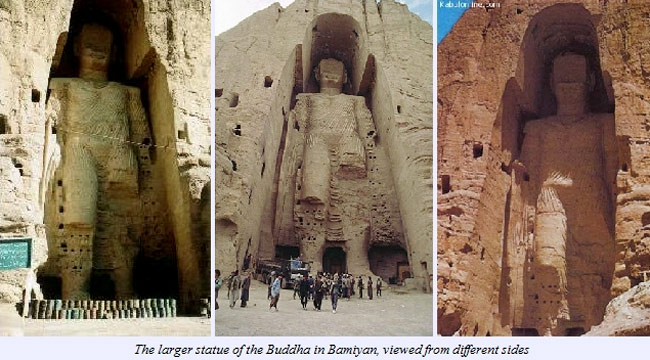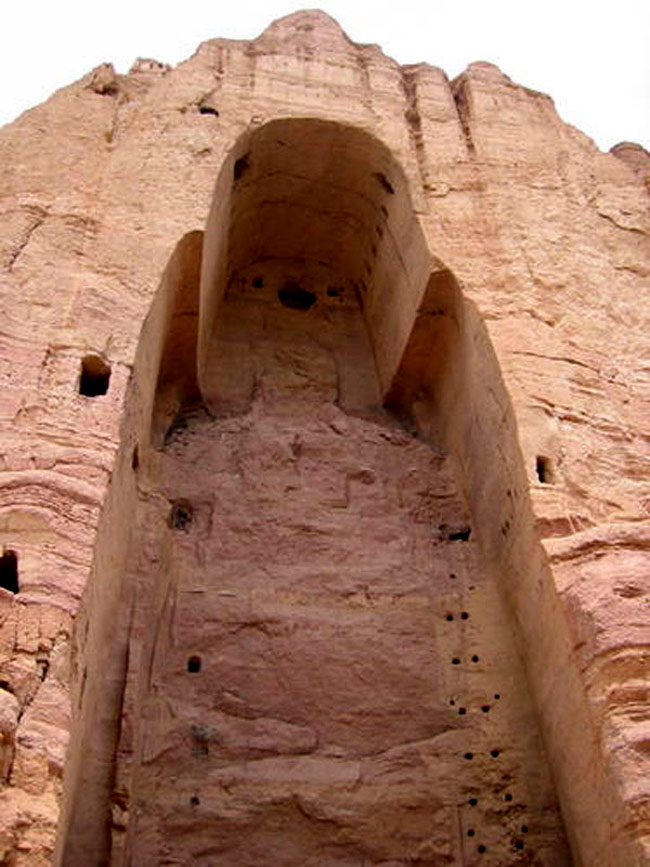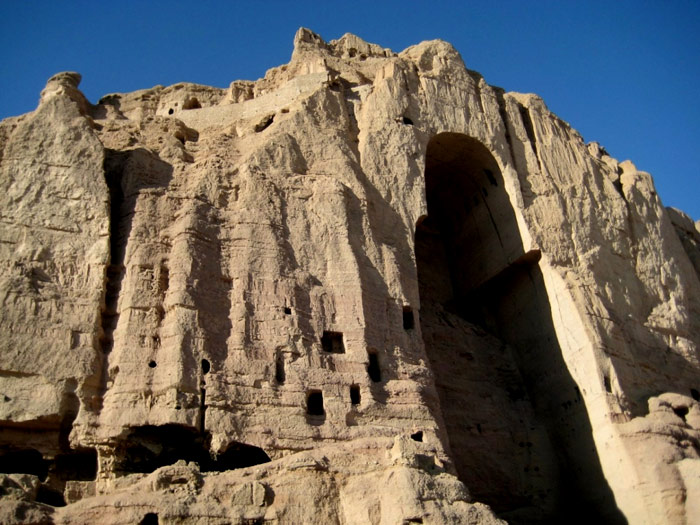Buddha statues at Bamiyan
The Buddha statues at Bamiyan, consisting of two Buddha statues carved into the rocky mountains of Bamiyan, Afghanistan, have been recognized by Unesco as a Cultural Heritage in 2003.

These are the two largest statues in the world carved into stone mountains . These two statues date back about 1,500 years ago. A 53m high statue and the remaining 38m high. The sad thing is that in March 2011, the Taliban government used explosives to knock down both statues. The whole world has helplessly witnessed the sight of two collapsed statues with regret that cannot be expressed in words. This Taliban non-cultural action has enraged the world and condemned it.

The statue, after being destroyed, has only 1 large cavity left on the rocky mountain.
Back in history, Afghanistan is the center of Buddhism flourishing around the time of the early AD thanks to the merit of Dharma of the great Asoka (Asoka) in the third century BC. This is the only silk road connecting the regions from East to West, from India and regional countries. High Buddhist monks often accompany merchants to propagate Dharma in new lands by this way. They often rested in the beautiful, long-time Bamiyan Valley, which became the center of spreading the Dharma, and the two tallest Buddha images in the world were also created at the beginning of this time. Even some famous Buddhist monks and historians in Buddhist history also appeared from this place. By the 7th century, Islam poured into Afghanistan, Buddhism was at risk of being annexed, the nobles increased slowly leaving Bamiyan. Buddhism here loses its status, leaving only temples and Buddha statues. Over time, temples were destroyed, the statues were also lost or destroyed. The two famous Bamiyan Buddha statues exist for over 1,500 years because they are touched by the cliff.

According to historical records of the time of the creation of the small Buddha statue (about 38m high) is in 507, the big Buddha statue (53m high) is 554. After these two giant statues were destroyed, the Taliban government also suffered perdition and it was believed to be a punishment for Taliban rebels.


Looking back from a distance, it is easy to see the image of the Buddha statue that shows the greatness of this statue.
Also after the two giant statues were destroyed, scientists discovered many interesting things: First, two carved Buddha statues are preliminary to the stone, then a mixture of soil is used. lightning, straw and horse tail feathers were dressed into costumes before coloring. Workers here have found more than 3,000 pieces of surface plastering with color-mixing materials and wooden wedges, a rope wrapped around the stone statue to hold the plaster. The dry climate in Afghanistan and the depth of the pit have protected the statue well and helped preserve the rustic part of the building.

Big Buddha statue is painted with red ants, while Small Buddha statue is painted with many colored materials. The most interesting discovery is a hand, which contains three ceramic rosaries, clay prints and a number of Buddhist scriptures printed on the bark. It can be said that the armrest is worn on the chest of the Big Buddha statue and is plastered during the completion of the statue.
 The statue foot area after being destroyed only left the ground.
The statue foot area after being destroyed only left the ground.
Today, although two of the world's oldest and largest Buddha statues in Bamiyan have been destroyed by guns of the Taliban extremist government, many Buddha statues have been and are still glorious in every person's mind throughout. five continents and in the history of mankind. The area that used to be the current two statues is still heavily guarded and scientists have carried out the restoration, preserving the two gaps in the cliff where the statue once stood.

- Top 10 world famous Buddha statues
- Discovered Buddha statues carved from extremely rare meteors
- China: Excavating the 1500-year-old Bodhisattva Buddha statue
- Mummy 1,000 years inside the Buddha image
- Found a thousand year old Buddha statue
- Marvel at the 7 tallest statues in the world
- Mount Emei and Great Lac Lac Buddha
- Inside the tallest stupa in Southeast Asia in Ninh Binh
- Discovered the precious Buddha statue in India
- The origin, meaning of Buddha's Birthday and rituals should be done on the sacred day
- Unique architecture of the world's largest stone Buddha statue
- Ancient Buddhist paintings at Bamiyan are painted with oil paint
 Suzhou classic bonsai garden - China
Suzhou classic bonsai garden - China Chau Nguyen Dynasty
Chau Nguyen Dynasty Thai Son Mountain - World Wonder
Thai Son Mountain - World Wonder Ancient villages of Shirakawa-go and Gokayama
Ancient villages of Shirakawa-go and Gokayama El Gigante: Easter Island's Most Mysterious Moai Statue
El Gigante: Easter Island's Most Mysterious Moai Statue  12 god statues discovered at Cambodia's Angkor Archaeological Park
12 god statues discovered at Cambodia's Angkor Archaeological Park  Laos continuously discovered Buddha statues believed to date back hundreds of years
Laos continuously discovered Buddha statues believed to date back hundreds of years  Excavation in Laos discovered many bronze Buddha statues
Excavation in Laos discovered many bronze Buddha statues  Making 3D printed statues honoring 120 outstanding contemporary female scientists
Making 3D printed statues honoring 120 outstanding contemporary female scientists  The thousand-year mystery of a lizard-man statue with a 'deformed' face
The thousand-year mystery of a lizard-man statue with a 'deformed' face 